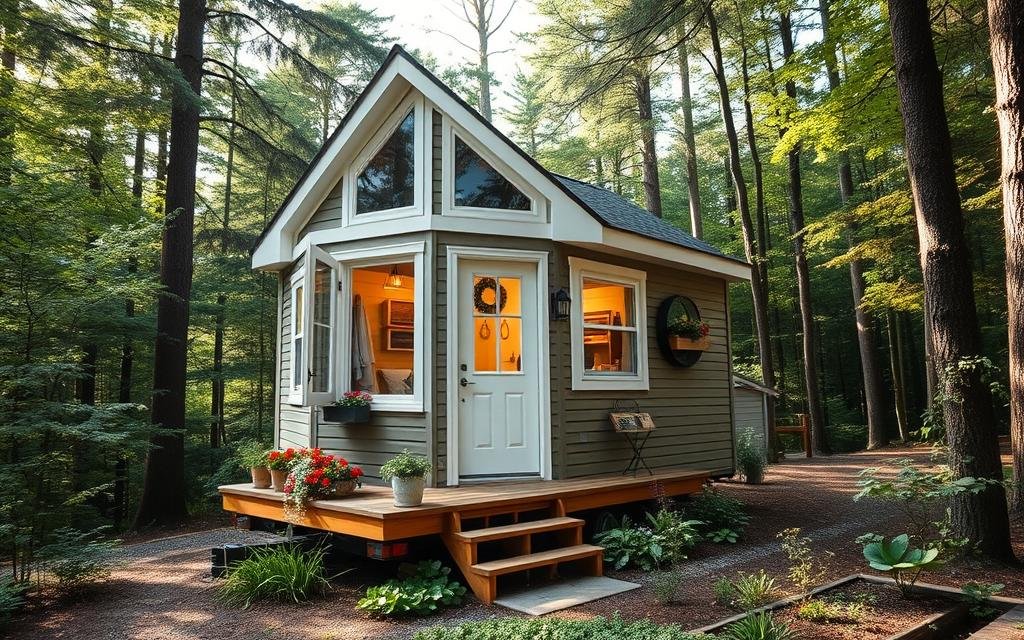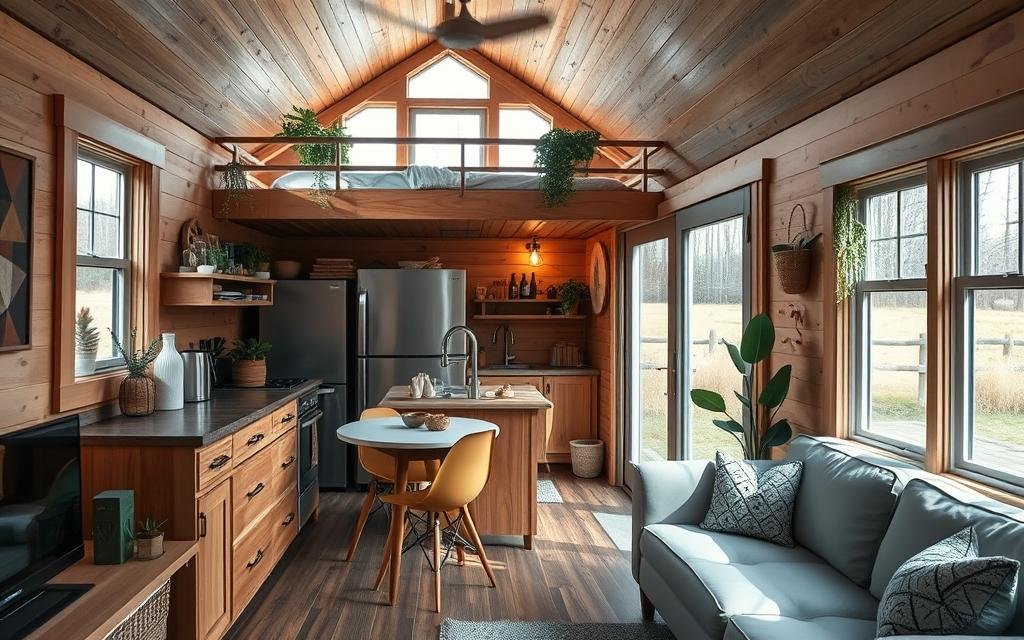Living in a compact dwelling in Florida comes with unique challenges. The state’s subtropical climate creates year-round environmental pressures that demand careful planning. From powerful storms to seasonal humidity, owners of smaller residences must adapt to conditions that test structural resilience and safety.
Coastal regions face the most intense threats, including hurricane-force winds and storm surges. Even inland areas aren’t immune to heavy rains or sudden temperature shifts. These factors require specialized construction techniques and materials to prevent costly damage.
Understanding regional climate patterns helps residents prepare effectively. Proper insulation, anchoring systems, and drainage solutions become critical for maintaining comfort and security. Insurance coverage should also reflect the specific needs of non-traditional housing in high-risk zones.
Local regulations and community resources play vital roles in sustainable living. Many neighborhoods now offer shared storm shelters and emergency plans tailored to alternative housing setups. Staying informed about weather updates and evacuation routes remains essential for year-round safety.
Table of Contents
Key Takeaways
- Florida’s climate demands specialized preparation for compact dwellings
- Hurricane risks require reinforced construction and anchoring systems
- Regional weather patterns dictate specific protection strategies
- Insurance policies should address unique structural vulnerabilities
- Community resources enhance safety during extreme events
- Proper drainage prevents water damage in flood-prone areas
Overview of Florida’s Extreme Weather Conditions
Beneath Florida’s sunny facade lies a battleground of atmospheric extremes. The state’s geographic position exposes it to converging weather systems that fuel destructive events. From sudden squalls to prolonged heat waves, these conditions demand constant vigilance from residents.
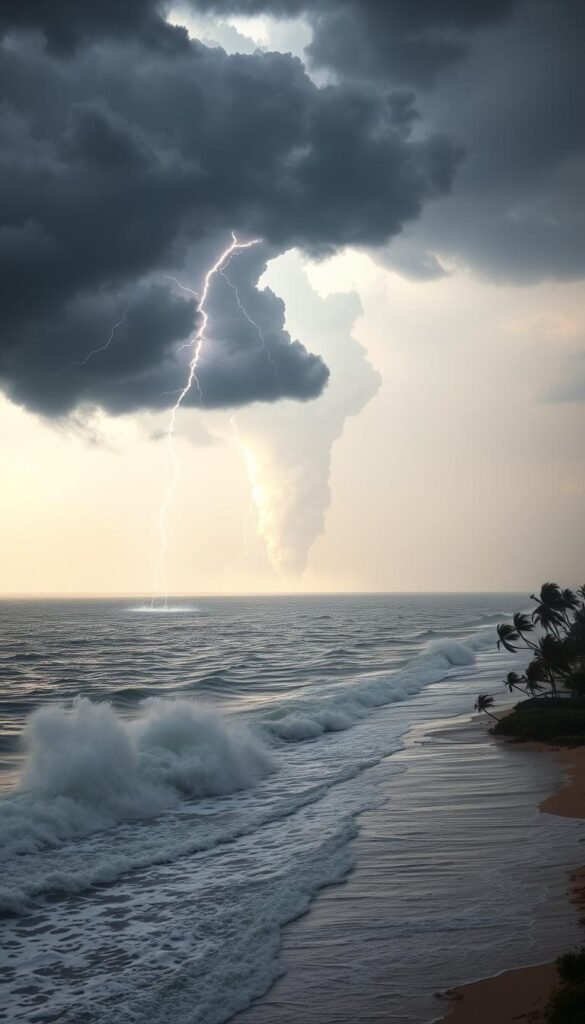
Common Weather Events in Florida
Powerful thunderstorms dominate summer months, unleashing wind gusts over 60 mph and torrential rains. Lightning strikes rank among the highest nationally, threatening electrical systems in compact dwellings. Between June and November, hurricane threats escalate, with storm surges pushing seawater miles inland.
Coastal zones endure salt spray corrosion and flooding during tropical cyclones. Inland regions face different challenges, including tornado outbreaks spawned by severe squall lines. Rapidly developing waterspouts sometimes move ashore, adding to destruction risks.
Seasonal Trends and Regional Variations
Summer brings daily thunderstorm activity, particularly in central counties where heat collisions spark afternoon deluges. Northern territories occasionally see winter freezes that test plumbing systems. The Panhandle experiences stronger temperature swings than southern peninsula communities.
Elevation changes under 300 feet create microclimates affecting storm paths. Lake-rich districts face intensified lightning activity, while coastal plains bear brunt of tropical systems. Understanding these patterns helps residents tailor preparedness strategies effectively.
Introduction to Tiny Houses in Florida
The rise of minimalist living spaces across the Sunshine State brings fresh opportunities and environmental considerations. These innovative dwellings combine efficient design with sustainable principles, but their reduced scale requires smart adaptations for regional climate demands.
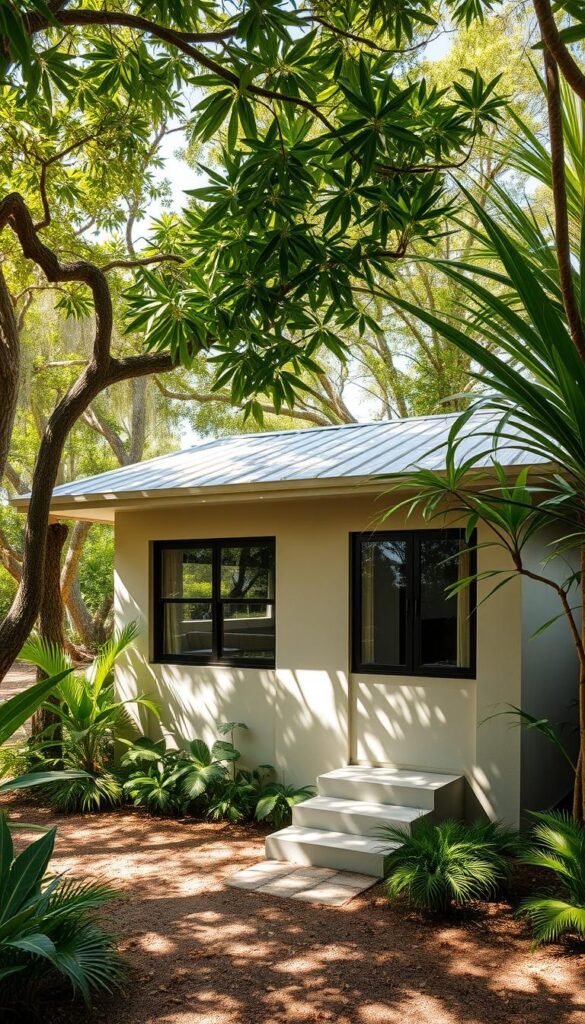
Design Characteristics of Modern Micro-Dwellings
Modern small-scale residences prioritize vertical storage and multi-functional furniture to maximize limited square footage. Many feature elevated foundations to mitigate flood risks and specialized roofing materials that deflect solar heat. Retractable awnings and hurricane-rated windows have become standard in coastal communities.
Balancing Comfort and Climate Realities
High humidity levels demand continuous airflow management through cross-ventilation systems and dehumidifiers. Energy-efficient mini-split AC units help maintain stable temperatures without overwhelming power grids. However, frequent rainfall tests waterproofing measures in roof seams and wall joints.
| Feature | Traditional Homes | Compact Dwellings |
|---|---|---|
| Construction Materials | Concrete block | Lightweight composites |
| Ventilation Needs | Central HVAC | Dual-purpose systems |
| Anchoring Systems | Permanent foundation | Mobile tie-downs |
| Insurance Costs | $1,200/year average | $1,800/year average |
Local zoning laws increasingly address permanent versus mobile configurations, particularly in flood-prone districts. Some neighborhoods now offer shared utility hubs to support off-grid capabilities during storms. Residents benefit from lower energy bills but face higher maintenance costs for weather-resistant finishes.
Tiny house weather risks in Florida
Florida’s climate tests small-scale residences with forces that magnify structural vulnerabilities. Compact designs often lack the mass and anchoring of traditional buildings, making wind resistance a critical concern. Gusts exceeding 50 mph can destabilize foundations, especially for mobile units on elevated platforms.
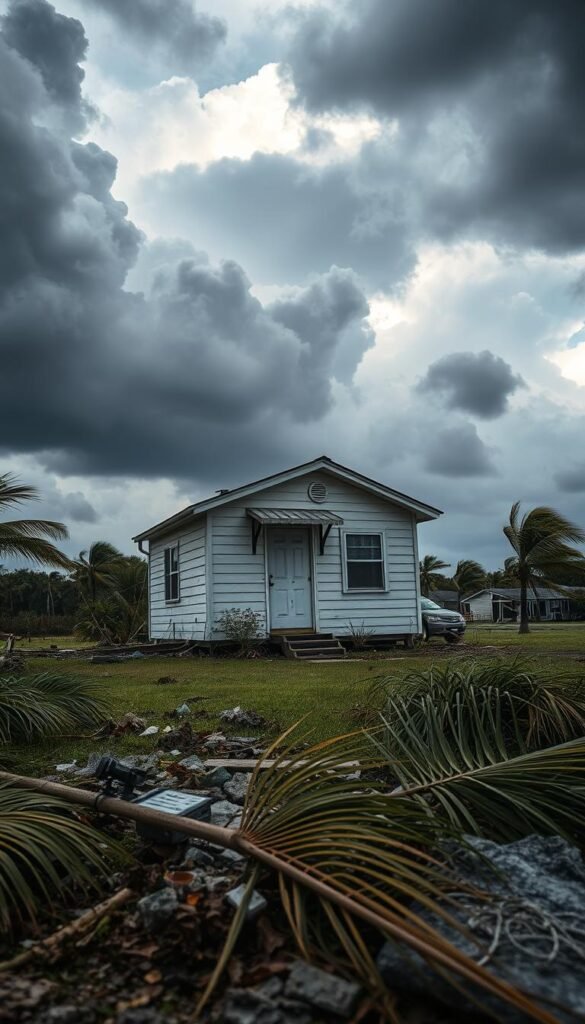
Coastal zones face amplified threats from storm surges that overwhelm drainage systems. Water intrusion becomes catastrophic in tight spaces, spreading mold and rot within hours. Electrical panels in micro-dwellings frequently fail during downpours due to limited redundancy in power distribution networks.
Three critical vulnerabilities demand attention:
- Wind uplift resistance for lightweight structures
- Flood-proofing measures in low-lying regions
- Moisture barriers for humidity control
Insurance claims reveal that 62% of weather-related property damage in these homes stems from roof failures. Strategic reinforcement of joints and weatherstripping around windows reduces repair costs significantly. Owners in high-risk areas should prioritize impact-resistant materials and elevated chassis designs.
Understanding High Winds and Storm Threats
Powerful air currents pose distinct challenges for compact living spaces across coastal regions. While hurricanes dominate headlines, straight-line winds from thunderstorms cause frequent structural stress. These horizontal gusts often strike without tornado warnings, accelerating damage risks.

Straight-Line Winds vs. Hurricanes
Thunderstorm-generated winds account for half of severe weather damage nationwide. Unlike swirling hurricane forces, these gusts travel in straight paths at 50-75 mph. They frequently topple lightweight buildings through sustained pressure rather than sudden impacts.
| Wind Speed (mph) | Effects | Protection Measures |
|---|---|---|
| 25-38 | Branch movement, walking difficulty | Secure outdoor items |
| 39-54 | Roof shingle loss, window cracks | Install storm shutters |
| 55-75 | Structural deformation | Reinforce anchoring systems |
| 75+ | Complete roof failure risk | Evacuate immediately |
Impact on Structural Integrity
Buildings with elevated designs face unique vulnerabilities during wind events. As speeds exceed 47 mph, uplift forces can displace entire structures lacking proper tie-downs. Roof seams and window seals become critical failure points during prolonged gusts.
Strategic reinforcements reduce repair costs by 68% according to storm safety studies. Cross-bracing wall frames and using aerodynamic roofing shapes help deflect intense airflows. Regular inspections of mounting hardware ensure ongoing protection against developing weather systems.
Assessing Flood and Water Damage Vulnerabilities
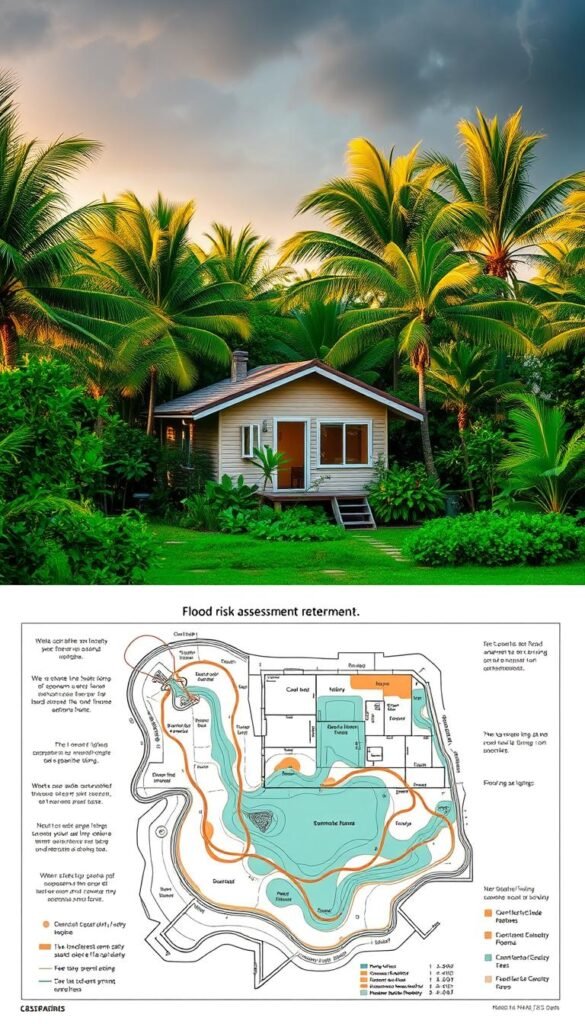
Water threats rank among the most persistent dangers for small-scale living spaces. Federal Emergency Management Agency (FEMA) flood maps provide baseline guidance, but their limitations require supplemental research. These documents outline 100-year floodplains – zones with 1% annual flooding probability – though 40% of insurance claims originate outside these designated high-risk areas.
Identifying Flood Zones and 100-Year Floodplains
FEMA’s mapping system faces critical gaps affecting micro-home safety. Over 3,300 communities rely on 15+ year-old data that excludes modern drainage changes and climate-driven rainfall patterns. Coastal developments and new construction projects often alter water flow paths in ways outdated maps don’t reflect.
| FEMA Map Data | Real-World Conditions |
|---|---|
| 1% annual flood risk | 26% of claims from moderate-risk zones |
| 15-year-old data average | 43% of communities report changed drainage |
| No climate projections | 19% increase in flash floods since 2010 |
Water Intrusion Prevention Techniques
Effective protection combines elevation strategies and landscape engineering. Raising structures 12+ inches above ground level reduces seepage risks during heavy rains. Grading slopes away from foundations and installing French drains prevents pooling near critical systems.
Sealing wall joints with waterproof membranes offers additional security. Electrical panels should mount at least 18 inches above potential flood lines. Regular gutter maintenance and downspout extensions keep moisture away from vulnerable entry points.
Hurricane Preparedness for Tiny Homes
Protecting compact living spaces from tropical cyclones demands proactive measures tailored to their unique design. These structures require specialized strategies combining mobility options with reinforced construction to withstand catastrophic weather events.
Strategic Evacuation Protocols
Mobile units offer relocation advantages but require pre-identified safe zones beyond floodplains. Stationary structures need evacuation plans with multiple route options updated annually. Community networks prove vital for sharing real-time storm updates and transportation resources.
| Preparation Type | Mobile Units | Fixed Structures |
|---|---|---|
| Lead Time | 48+ hours before landfall | 72+ hours before landfall |
| Key Supplies | Tire kits, hitch locks | Sandbags, plywood sheets |
| Documentation | Tow vehicle registration | Foundation permits |
Wind Resistance Upgrades
Lightweight construction necessitates hurricane straps rated for 150+ mph winds. Triple-reinforced window seals and aerodynamic roofing reduce uplift risks during sustained gusts. Remove potential projectiles like patio furniture before storms approach.
| Reinforcement | Cost Range | Effectiveness |
|---|---|---|
| Ground anchors | $200-$500 | 38% damage reduction |
| Impact shutters | $1,200-$3,000 | 67% breach prevention |
| Wall bracing | $800-$1,500 | 54% structural integrity |
Insurance documentation should include timestamped photos of all upgrades. Store emergency kits in waterproof containers near primary exits for quick access during evacuations.
Navigating Insurance and Coverage Options
Securing adequate protection for unconventional dwellings requires careful navigation of complex insurance landscapes. Florida’s unique climate risks demand policies addressing both structural vulnerabilities and regulatory requirements. Owners must balance affordability with comprehensive safeguards against extreme weather impacts.
Choosing the Right Property Insurance
Mobile units often require RV insurance endorsements, while permanent structures need modified homeowners’ policies. The Florida insurance market’s volatility makes working with agents experienced in alternative housing crucial. Verify whether policies cover replacement costs or actual cash value for total loss scenarios.
Understanding Market Trends and Policy Details
Recent premium hikes and carrier exits force owners to scrutinize coverage exclusions. Many standard plans omit flood damage or require wind-resistant upgrades for claims approval. States like California mandate hazard zone disclosures, while others follow “buyer beware” rules for material defects.
Review policy language regarding anchoring systems and storm-proof materials. Document upgrades with timestamps to streamline claim processes. Combine specialized coverage with community flood plans for layered protection against Florida’s unpredictable climate.


